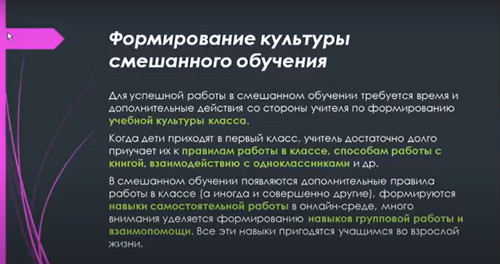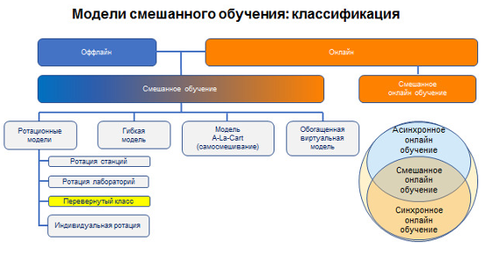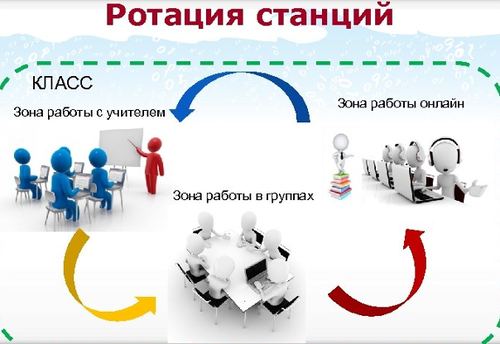On October 8, 2022, a methodological seminar on the topic "Organization of the learning environment in the classroom with a blended learning format" was held on the Zoom platform. Within the framework of the seminar, IITU experts revealed the content of the concept of "learning environment", spoke about the specifics of the blended learning format, and also described such blended learning models as "Flipped Classroom" and "Station Rotation".
During the report, Elmira Yerkebekova, Candidate of Philological Sciences and Associate Professor noted that the learning environment is made up of several factors. Firstly, the learning environment is influenced by operational principles such as the organization of the educational process, the relationship between the teacher and students and their attitude towards the lesson. Secondly, it is influenced by such physical elements as comfortable furniture arrangement, access to gadgets and the Internet, and the presence of stands, posters and illustrations that help students visually perceive information, and get involved in the material they are learning.
According to Elmira Kaldybekovna a favorable classroom environment for comfortable learning is the mood of the student and teacher. This is an environment where students are motivated to expand knowledge, develop skills, and increase self-esteem. The experience of the teacher helps to organize such a learning environment. In a safe learning environment, students are more open, ready to share their thoughts, ask questions, and take part in dialogues. They have a desire to go to a class where they are expected, where they are welcome and where they feel comfortable.
There are many ways and strategies that allow to organize a comfortable learning environment. Elmira Kaldybekovna says that one of them is the joint development of rules for the class.
Students, together with the teacher, develop rules and fix them on the stand. An important point is to avoid such phrases as "You must!" The wording of the rules should be organized in such a way to make the students like it. It can be done by analogy with the now popular "House and Kitchen Rules" as they are focused on relationships and mood.
As an example, she suggested the following rules:
- Love and support each other.
- Always tell the truth.
- Believe in yourself and in miracles.
- Start a new day with a smile.
- Laugh a lot.
- Keep promises.
Elmira Kaldybekovna emphasizes that the rules the students and the teacher will create for their class will help maintain discipline and a positive attitude as they will be common for everyone. Naturally, there will be some rules for younger grades, and others for older ones.
Akelius' great how-to guide provides examples of highly recommended printed materials to hang in the classroom. In addition to the rules stand, Akelius recommends placing the following:
- graphs that reflect work on a number of topics;
- the best work of students to increase motivation (can be changed weekly or monthly);
- interactive written texts (texts with pictures for kids);
- books from the classroom library to read during breaks.
In addition, Elmira Kaldybekovna recommends creating a playlist and turning on music during breaks to create a good working mood in the class. Such music will be especially useful on cloudy days.

Her colleague, Yevgeniy Medvedev, Ph.D. and assistant professor spoke about the formation of a culture of blended learning and its most common models “Flipped Classroom” and “Station Rotation”.
According to him in the traditional educational process, the teacher explains a new topic to students in the classroom, and gives a task for home assignment. The “Flipped Classroom” model implies that the student learns new material at home using electronic means, textbooks or additional materials, and completes assignments in the classroom, in the presence of the teacher. Such a model does not allow students to copy each other's homework.”
Also, with the “Flipped Classroom” model, a student who did not understand something while independently studying a new topic can formulate a specific question and discuss it in class.

The principle of working according to another model called “Station Rotation” is that the teacher divides the students into several groups and gives each one a specific task. At the same time, the classroom should be divided into three zones: the zone of work with the teacher, the zone of work in groups and the zone of online work (or the zone of practical, independent work). Students will have an individual timetable that will allow them to move around the stations.
Yevgeniy Yuryevich says that in the system-activity approach the teacher speaks for no more than 10 minutes, and the students work independently for at least 50% of lesson time. With a blended learning format, this is easily accomplished using the Station Rotation model. Today it is one of the most popular models of blended learning format.

According to him, there are many options for rotating stations: you can divide the class into three or four groups and make the same number of stations, or reduce their number to two - here the teacher has a lot of freedom in action. In the “Station Rotation” model, it is convenient to work out gaps in knowledge. You can conduct a test in Google Forms to identify the rules that cause difficulties for students, group them according to these criteria, and formulate separate tasks for practicing specific rules.
Yevgeniy Yuryevich notes that with the “Station Rotation” model, the teacher has the opportunity to approach students more individually as he will not have to work with the whole class at the same time. Thus, the teacher will be able to clarify the most difficult points that the students did not understand, sort out typical mistakes, and check the assimilation of the material.

Akelius platform, which is aimed at improving literacy and developing digital skills in children who have arrived in Kazakhstan from abroad and found themselves in a difficult life situation can be used for the online work zone in Russian language lessons. IITU has been participating in a joint project with Akelius and UNICEF since November 2021. 9 schools of Kazakhstan take part in the project.
You can view the methodical seminar at the following link:
https://drive.google.com/file/d/1q1lkMlkWv_ZyFxcFCD-tncJxKCcofXnz/view
